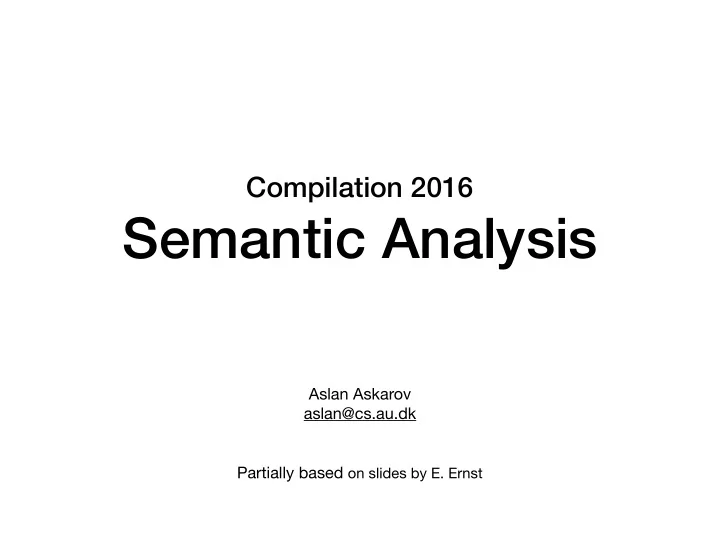

Compilation 2016 Semantic Analysis Aslan Askarov aslan@cs.au.dk Partially based on slides by E. Ernst
Where are we • Earlier this week: • Abstract syntax trees – tree representation of a program • Scoping rule – how to interpret declarations • Environments – implementation infrastructure • Today: • Semantic analysis
Goals of the semantic analysis • Checking that input program is well-typed • i.e., checking that AST produced by the parser adheres to the typing rules of the language. • Generally, after this phase, most errors are reported to the user • Generating typed-AST for later compiler phases
From AST to typed-AST • Typed AST is an abstract syntax tree decorated with type information • we may also throw away source-level position information, because it is strictly speaking not needed from this point on
TigerLight 0 • The language of missing features :) • No loops } ⇒ let declarations only include vars • No functions • No user-def types • types range only over int, string, and unit • No arrays or records • No references • No dangling else • Only basic integer operators over expressions
TigerLight 0 let var x : Int := 10 var s : String := “hi” in if x then s else 42 end Is this program well-typed?
TigerLight 0 >_
Tiger Types structure Types : TYPES = struct type unique = unit ref datatype ty = INT | STRING | RECORD of (Symbol.symbol * ty) list * unique | ARRAY of ty * unique | NIL | UNIT | NAME of Symbol.symbol * ty option ref | ERROR (* ambiguity exists due to type error *) end
Uniqueness: nominal type equivalence • Nominal type equivalence known from Java etc.: class C1 {.. /* some declarations */ ..} class C2 {.. /* identical to C1, rename as needed */ ..} • Even though declarations are identical, these classes are not the same type • Tiger uses nominal type eq. for records and arrays: ‘unit ref’ is always a unique value structure Types : TYPES = struct type unique = unit ref datatype ty = ... | RECORD of (Symbol.symbol * ty) list * unique | ARRAY of ty * unique ... end
⇒ Uniqueness: Quiz • Q: How else could you implement this? TypeDec TypeDec another AST traversal 'rectype2' 'rectype2' RecordTy RecordTy unique_id 'name' 'dates' 'name' 'dates' 238378 'string' 'arrtype 'string' 1' 'arrtype1' A separate AST traversal to generate unique identifiers for each record/array declaration would be a cleaner implementation approach, but at the cost of writing/maintaining an extra AST pass; so the unit ref hack is okay
Tiger declarations • let function = … type = … • Compared to TigerLight 0 semantic analysis for the full Tiger language needs two environments • variable (and function) environment • type environment • We extend our implementation so transExp and friends take an extra environment argument transExp (venv, tenv) exp
Summary • Semantic analysis: Above CFG, general • Major element: Type-checking: well-formedness, representation, choice of variant, … • From AST to typed AST • Tool: Symbol table (imp./func.), stack discipline • Representation of types, environments • nominal types • Type-checking declarations
Recommend
More recommend